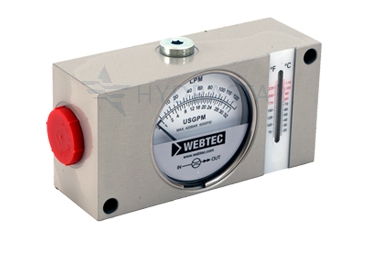If you run any kind of hydraulic system, the machinery will probably come with a hydraulic inline flow indicator attached. These simple devices measure the flow of hydraulic fluid through a chamber via a turbine or depressed piston, giving an analogue or digital readout in UK gallons per minute (UK GPM) alongside a standard centigrade temperature measurement. Litres per minute (LPM) is used on European devices.
Indicators are usually mounted at an easily accessible point between the main fluid pump and the serving hydraulic pistons. This ‘at-a-glance’ data flow allows the hydraulic operator to keep an eye on the system’s performance and adjust the machine manually to counter any problems with excessive viscosity. The flow indicator also acts as an early warning system for any blockages, unclean piping, and pipeline leaks.
But what if your flow indicator starts malfunctioning? Inaccurate, unrealistic, or dead readings or an unresponsive system could be signs that you need to replace your meter as soon as possible.
Dead, Jittery, or Surreal Needle
Many hydraulic indicators display the rate of inflow as a figure on a variable gauge. Inside gear and turbine inline flow meters, the needle is moved by a rotating cog or open blade wheel. This revolving disk hits an indicator mechanism, pushing the needle to a set measurement based on the number of strikes per minute. In variable orifice meters, the same effect is achieved via a depressed piston.
Watch the meter carefully while the hydraulic machine is being operated. Is the needle failing to move, stuck on one number, or jammed at the top end of the meter? If the needle is still moving, is it repeatedly highlighting completely unrealistic rate numbers?
If so, the internal mechanism may be gummed with fluid, jammed, misaligned, or sheared. Gear meters are particularly susceptible to an internal mechanical failure due to the nature of their fine teeth. Similarly, machines that use low-lubrication, high-viscosity fluid should be checked regularly for indicator failure.
Full replacement of the faulty component is usually recommended. You may be able to salvage certain meters with enough time and spare parts. Less complex variable orifice pistons are usually easier to unstick or replace.
Thermometer Faults
Most indicators come with an internal bar thermometer attached to monitor the pipeline heat being generated by your hydraulic system. However, traditional glass thermometers are vulnerable to background vibrations and extremes of heat. Hydraulic systems excel at generating both.
If your thermometer is refusing to indicate or is stuck at one temperature, it’s time to consider replacing the unit. Dampening fluid can help to mitigate the effects of hydraulics on your temperature meter.
Stuck or Leaking Hydraulic Fluid
If the meter’s GPM/LPM drops to zero and you’re not getting a response from your hydraulic machinery, the meter itself may be inhibiting your system. A faulty indicator can block pressurisation, leak hydraulic fluid, or lower the rate at which fluid reaches the serving cylinders. This can occur due to internal part fatigue, adapter or valve misalignment or overtightening, or outside detritus entering the indicator.
Look carefully for the tell-tale signs of any leaks in the form of hydraulic fluid puddles, hissing, or breaks in the pipelines, casing, and seals surrounding the indicator. If a break is also present in the surrounding equipment or adaptors you will have to replace them as well.
For your personal safety make sure the machine is completely turned off and depressurised before searching for breaches. You should never handle hydraulic machinery or pipelines with your bare hands. For all questions about hydraulic systems please contact our team on 01353 721704.



